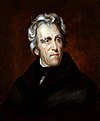John Branch
John Branch | |
|---|---|
 | |
| 19th Governor of North Carolina | |
| In office December 6, 1817 – December 7, 1820 | |
| Preceded by | William Miller |
| Succeeded by | Jesse Franklin |
| United States Senator from North Carolina | |
| In office March 4, 1823 – March 9, 1829 | |
| Preceded by | Montfort Stokes |
| Succeeded by | Bedford Brown |
| 8th United States Secretary of the Navy | |
| In office March 9, 1829 – May 12, 1831 | |
| President | Andrew Jackson |
| Preceded by | Samuel L. Southard |
| Succeeded by | Levi Woodbury |
| Member of the U.S. House of Representatives from North Carolina's 2nd district | |
| In office May 12, 1831 – March 3, 1833 | |
| Preceded by | Willis Alston |
| Succeeded by | Jesse A. Bynum |
| 6th Territorial Governor of Florida | |
| In office August 11, 1844 – June 25, 1845 | |
| Preceded by | Richard K. Call |
| Succeeded by | William Dunn Moseley (as Governor of the State of Florida) |
| Member of the North Carolina Senate | |
| In office 1811–1817 | |
| Personal details | |
| Born | November 4, 1782 Halifax County, North Carolina |
| Died | January 3, 1863 (aged 80) Halifax County, North Carolina |
| Political party | Democratic-Republican Democratic |
| Spouse | Elizabeth Forte (d.Jan 19, 1854) Mary Elizabeth Jordan Bond |
| Alma mater | University of North Carolina at Chapel Hill |
| Profession | Politician, lawyer, farmer |
John Branch, Jr. (November 4, 1782 – January 3, 1863) was an American politician who served as U.S. Senator, Secretary of the Navy, the 19th Governor of the state of North Carolina, and was the sixth and last territorial governor of Florida.
Branch was born in Halifax County, North Carolina, on November 4, 1782, the son of wealthy landowners. Educated at the University of North Carolina, where he was a member of the Philanthropic Society, he occupied himself as a planter and civic leader. Branch served in the North Carolina Senate from 1811 to 1817 and was the state's Governor from 1817 to 1820. After further service in the state Senate, he represented North Carolina in the United States Senate from 1823 until 1829 and was a strong supporter of Andrew Jackson.
When Jackson became President, he selected Branch as his Secretary of the Navy. In that post, Branch promoted several reforms in the Navy's policies and administration, many of which were not implemented until years later. He reduced the resources going to the construction of new ships, while increasing those applied to keeping existing vessels in good repair. Branch also sent the frigate USS Potomac to the Far East to punish the murderers of a U.S. merchant ship's crew and to generally promote and protect American commerce in the region.
John Branch resigned as Secretary in 1831, during the Petticoat affair, which involved the social ostracism of Margaret O'Neill Eaton, the wife of Secretary of War John H. Eaton by a group of Cabinet members and their wives led by Floride Calhoun, the wife of Vice President John C. Calhoun. Later that year, Branch was elected to the U.S. House of Representatives as a Jacksonian and later to North Carolina state political offices. In the mid-1830s, he moved to Leon County, Florida, where he lived for much of the next decade-and-a-half on his Live Oak Plantation. In 1844, President John Tyler appointed him Florida's territorial governor until the 1845 election of a governor under the state constitution. Branch returned to North Carolina in the early 1850s, remaining there until his death on January 4, 1863.
Branch is buried in Elmwood Cemetery in Enfield, North Carolina.
Branch was an uncle of the Confederate General Lawrence O'Bryan Branch.
Bibliography
- American National Biography
- Dictionary of American Biography
- Haywood, Marshall Delancey. John Branch: 1782-1863. Raleigh, NC: Commercial Printing Co., 1915
- Hoffmann, William S. John Branch and the Origins of the Whig Party in North Carolina. North Carolina Historical Review 35 (July 1958): 299-315
See also
- Branch County, Michigan - A county in Michigan that was named after him
Sources
 This article incorporates public domain material from websites or documents of the Naval History and Heritage Command.
This article incorporates public domain material from websites or documents of the Naval History and Heritage Command.- Biographical Directory of the United States Congress
External links
- 1782 births
- 1863 deaths
- Governors of Florida Territory
- Governors of North Carolina
- United States Secretaries of the Navy
- United States Senators from North Carolina
- Members of the United States House of Representatives from North Carolina
- North Carolina State Senators
- American planters
- North Carolina Democratic-Republicans
- North Carolina Democrats
- North Carolina Jacksonians
- Democratic-Republican Party United States Senators
- Jackson administration cabinet members
- Jacksonian members of the United States House of Representatives
- Democratic-Republican Party state governors of the United States
- 19th-century American politicians







